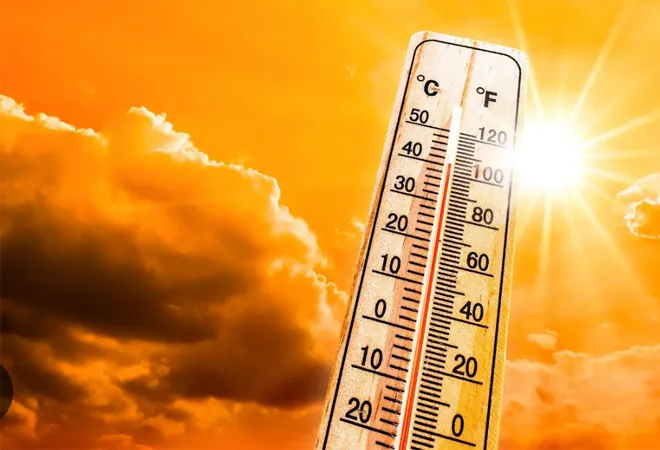
India is currently facing a severe heat wave that arrived much early in 2023. On 18 April 2023, the maximum temperature over
60 percent of India or 22 states/Union Territories was recorded higher than the normal range. The heat wave is officially declared
when the temperature in the plains reaches a minimum of 40 degrees Celsius, at least 37 degrees Celsius in coastal areas, and a minimum of 30 degrees Celsius in hilly regions, with a departure from the normal temperature of at least 4.5 degrees.
Although heat waves have caused a significant number of deaths in India between 1992 and 2015, totalling
24,223, they have not received the same level of public attention as other more dramatic disasters such as floods and earthquakes. There was no national-level strategy or vision to address heat waves as a disaster until recently. Prior to 2015, the deaths and illnesses caused by
heat waves were not given due recognition as hazards at the national level. The Central and State governments had a response-centric approach towards heat waves, with little emphasis on risk reduction. State governments were permitted to allocate up to
10 percent of the State Disaster Response Fund (SDRF) towards addressing local disasters (heatwaves were declared as local disasters).
Although heat waves have caused a significant number of deaths in India between 1992 and 2015, totalling 24,223, they have not received the same level of public attention as other more dramatic disasters such as floods and earthquakes
India is one of the countries most affected by climate change and is particularly vulnerable to the impacts of heat waves due to its high population density, lack of adequate infrastructure, and limited access to healthcare.
A recent study by the World Weather Attribution Network has revealed that the early and abnormal heatwaves that swept across India and Pakistan in 2022 were made 30 times more probable by the direct impact of climate change. According to a study conducted by researchers from the University of Cambridge, India has already been significantly affected by heat waves, resulting in power shortages, elevated levels of dust and air pollution, and accelerated melting of glaciers in the northern regions of India.
During extreme heat, certain groups of people who are more vulnerable, including older adults, children, pregnant women, outdoor workers, individuals with chronic illnesses, socially or geographically isolated people, and some racial and ethnic subgroups (especially those with low socioeconomic status), experience higher rates of illness and death. Supporting this, a
report published by National Disaster Management Authority (NDMA), points out that heat-wave victims are mostly the poor and vulnerable population in the
unorganised sectors, including daily-wage labourers, street vendors, brickmaking workers, construction workers, rickshaw pullers, delivery executives, gig workers, etc. These individuals are compelled to work outdoors due to their economic circumstances and earn a livelihood. Since they are unable to avoid being outside, they are particularly vulnerable to the hazardsposed by heatwaves.
For instance, in 2022, the heatwave that swept Delhi in March 2022, threw many livelihoods out of gear during the summer months. Further, according to reports, 13 individuals
succumbed to heatstroke on 16 April 2023. Continued exposure to prolonged high temperatures not only causes heat exhaustion and heat stroke but can exacerbate a wide range of medical issues. According to a study published in the
American Journal of Preventive Medicine, 2013, the health risks associated with heat become more severe when combined with factors such as air pollution, high levels of humidity, and insufficient access to air conditioning.
Additionally, a study conducted by the University of Cambridge revealed that
90 percent of the country was susceptible to experiencing a decline in livelihood capabilities, crop yields, increased spread of vector-borne diseases, and impaired urban sustainability due to the effects of heat. Heatwaves can cause acute impacts on large populations for short periods, triggering public health emergencies, leading to excess mortality and resulting in a domino effect of socioeconomic impacts, such as
decreased work capacity and labour productivity. As per International Labour Organization (ILO) (2019) report, India experienced a loss of approximately
4.3 percent of working hours in 1995 due to heat stress, and it is anticipated to increase to
5.8 percent by 2030.
According to a
research article by Hatvani-Kovacs (2016), studies focusing on the negative impacts of heatwaves have primarily concentrated on the health consequences, while comparatively fewer studies have delved into the effects of heatwaves on electricity and water demand. The use of air conditioning during heatwaves can disproportionately increase electricity demand, leading to power outages. Rising electricity prices can contribute to energy poverty, where householders cannot afford to heat or cool their homes sufficiently. Moreover, extensive use
of air conditioning can worsen urban heat island effects (UHIEs), and there is concern that
dependence on air conditioning can become addictive. Additionally, excessive water use during heatwaves can exacerbate water scarcity issues in cities, particularly those already struggling with water management challenges due to climate change.
Mitigation measures
Recognising the likely impact of heatwave, the Government of India has taken several measures to mitigate the impact of heat waves. For instance, the National Disaster Management Authority (NDMA) has developed
National Guidelines on Heat Wave Management to guide state governments and other stakeholders in developing heat wave management plans. The Ministry of Health and Family Welfare has issued advisories to all states and union territories on the
need for preparedness and response measures during heat waves. The government has also launched a Heat Health Action Plan (HHAP) in some cities while the
Ministry of Labour and Employment urged all states and UTs to take necessary steps towards preparedness and effective management of the ensuing heatwave conditions for workers and labourers employed in various sectors. For instance, the Centre issued an
advisory asking for rescheduling working hours for workers and labourers across different sectors. These measures are critical in ensuring that the impact of heat waves on public health is minimised, and the population is prepared to deal with the adverse effects of climate change.
The government is not the only one taking action. People in India have also adopted some coping mechanisms in the form of recent
lifestyle changes to reduce the impact of growing heatwaves on them. For instance, many people in India are now installing solar-powered appliances such as fans and air conditioners to stay cool and comfortable. With frequent power outages during heatwaves, this has become essential. Additionally, some people are using heat-resistant building materials such as cool roofs and thermal insulation to reduce the indoor temperature of their homes. Trees and vegetation can provide shade and help to cool the air around them, and some people in India are now planting more trees and vegetation in their neighbourhoods to create a cooler and more pleasant environment. Some cities in India have set up public cooling centres during heatwaves, where people can go to cool off and avoid heat-related illnesses. In some workplaces, employers are adjusting work schedules to avoid the hottest part of the day, by starting work earlier.
The current heat wave situation in India is a wake-up call for the need to address the impact of changing climate on public health. The increasing frequency and severity of heat waves are posing significant challenges to the most vulnerable populations, and it is crucial for the government and relevant stakeholders to take action for preparedness and mitigation to reduce the impact of heat waves. One of the key strategies is to improve early warning systems for heat waves, as this can help people to take preventive measures such as staying hydrated and avoiding outdoor activities during the hottest times of the day. According to an article in World Economic Forum (WEF), in addition, the
government should invest in creating more cooling shelters and green spaces, particularly in urban areas, to provide relief during heat waves. Awareness campaigns about the risks of heat waves and how to stay safe during such events are essential. This can include promoting lifestyle changes such as the use of light-coloured, loose-fitting clothing, drinking plenty of fluids, and taking frequent breaks in shaded areas.
Aditi Madan is an Associate Fellow at the Institute for Human Development and Editorial Coordinator with the National Institute of Disaster Management.
The views expressed above belong to the author(s). ORF research and analyses now available on Telegram! Click here to access our curated content — blogs, longforms and interviews.



 India is currently facing a severe heat wave that arrived much early in 2023. On 18 April 2023, the maximum temperature over
India is currently facing a severe heat wave that arrived much early in 2023. On 18 April 2023, the maximum temperature over  PREV
PREV


